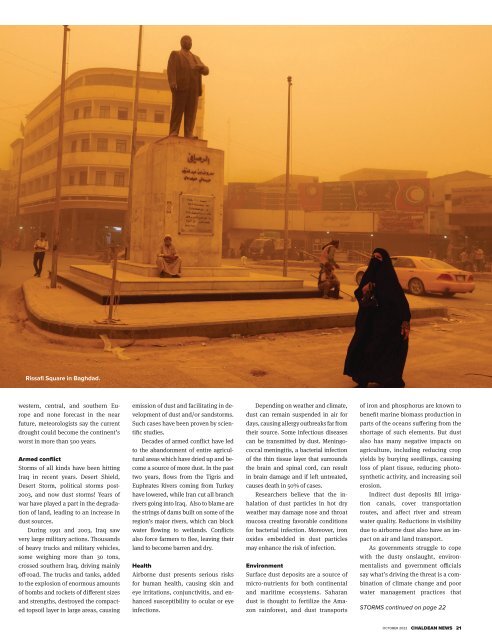Create successful ePaper yourself
Turn your PDF publications into a flip-book with our unique Google optimized e-Paper software.
Rissafi Square in Baghdad.<br />
western, central, and southern Europe<br />
and none forecast in the near<br />
future, meteorologists say the current<br />
drought could become the continent’s<br />
worst in more than 500 years.<br />
Armed conflict<br />
Storms of all kinds have been hitting<br />
Iraq in recent years. Desert Shield,<br />
Desert Storm, political storms post-<br />
2003, and now dust storms! Years of<br />
war have played a part in the degradation<br />
of land, leading to an increase in<br />
dust sources.<br />
During 1991 and 2003, Iraq saw<br />
very large military actions. Thousands<br />
of heavy trucks and military vehicles,<br />
some weighing more than 30 tons,<br />
crossed southern Iraq, driving mainly<br />
off-road. The trucks and tanks, added<br />
to the explosion of enormous amounts<br />
of bombs and rockets of different sizes<br />
and strengths, destroyed the compacted<br />
topsoil layer in large areas, causing<br />
emission of dust and facilitating in development<br />
of dust and/or sandstorms.<br />
Such cases have been proven by scientific<br />
studies.<br />
Decades of armed conflict have led<br />
to the abandonment of entire agricultural<br />
areas which have dried up and become<br />
a source of more dust. In the past<br />
two years, flows from the Tigris and<br />
Euphrates Rivers coming from Turkey<br />
have lowered, while Iran cut all branch<br />
rivers going into Iraq. Also to blame are<br />
the strings of dams built on some of the<br />
region’s major rivers, which can block<br />
water flowing to wetlands. Conflicts<br />
also force farmers to flee, leaving their<br />
land to become barren and dry.<br />
Health<br />
Airborne dust presents serious risks<br />
for human health, causing skin and<br />
eye irritations, conjunctivitis, and enhanced<br />
susceptibility to ocular or eye<br />
infections.<br />
Depending on weather and climate,<br />
dust can remain suspended in air for<br />
days, causing allergy outbreaks far from<br />
their source. Some infectious diseases<br />
can be transmitted by dust. Meningococcal<br />
meningitis, a bacterial infection<br />
of the thin tissue layer that surrounds<br />
the brain and spinal cord, can result<br />
in brain damage and if left untreated,<br />
causes death in 50% of cases.<br />
Researchers believe that the inhalation<br />
of dust particles in hot dry<br />
weather may damage nose and throat<br />
mucosa creating favorable conditions<br />
for bacterial infection. Moreover, iron<br />
oxides embedded in dust particles<br />
may enhance the risk of infection.<br />
Environment<br />
Surface dust deposits are a source of<br />
micro-nutrients for both continental<br />
and maritime ecosystems. Saharan<br />
dust is thought to fertilize the Amazon<br />
rainforest, and dust transports<br />
of iron and phosphorus are known to<br />
benefit marine biomass production in<br />
parts of the oceans suffering from the<br />
shortage of such elements. But dust<br />
also has many negative impacts on<br />
agriculture, including reducing crop<br />
yields by burying seedlings, causing<br />
loss of plant tissue, reducing photosynthetic<br />
activity, and increasing soil<br />
erosion.<br />
Indirect dust deposits fill irrigation<br />
canals, cover transportation<br />
routes, and affect river and stream<br />
water quality. Reductions in visibility<br />
due to airborne dust also have an impact<br />
on air and land transport.<br />
As governments struggle to cope<br />
with the dusty onslaught, environmentalists<br />
and government officials<br />
say what’s driving the threat is a combination<br />
of climate change and poor<br />
water management practices that<br />
STORMS continued on page 22<br />
<strong>OCTOBER</strong> <strong>2022</strong> CHALDEAN NEWS 21

















